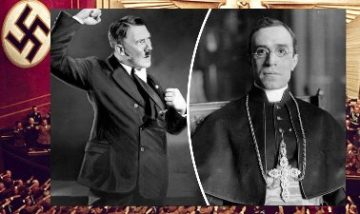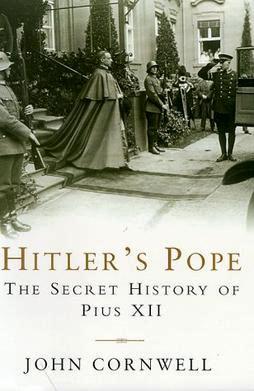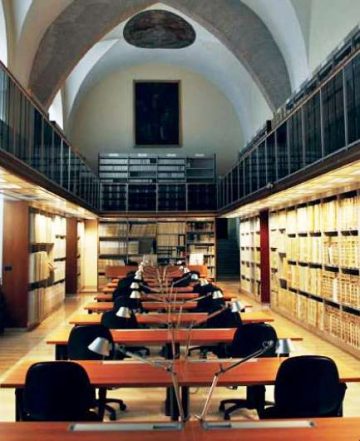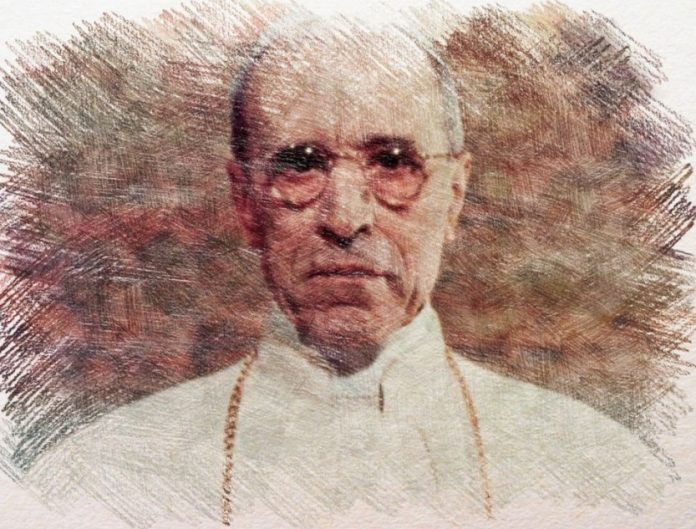For our struggle is not against flesh and blood; but against principalities and power, against the rulers of the world of this darkness, against the spirits of wickedness in the high places. Ephesians 6:12
On March 2nd, the remaining archives from Pius XII’s pontificate were officially opened to historians who, at long last, will be able to examine secret records of the war-time pontiff’s activities on behalf of endangered Jews, Christians and others. And hopefully, his good name and reputation will be restored after the decades-long assault claiming he was ‘Hitler’s Pope’ – a claim that has stubbornly persisted, contrary to the facts of his papacy which began in April 1939 as the world teetered on the edge of another world war.
Indeed, the choice of Eugenio Pacelli at such a critical hour in world history appears inspired as every aspect of his life to that date looks to have prepared him for the arduous task ahead – including his experiences as Apostolic Nuncio to Bavaria from 1917 to 1925 and Apostolic Nuncio to Prussia from 1926-1929.
And from the very beginning the signs of his grace and grit were evident in his very first encyclical – Summi Pontificatus – issued October 20, 1939, just weeks after the Nazi invasion of Poland triggered the outbreak of World War II. In it, the newly elevated pontiff condemned theories which deified the State and denied the unity of the human race. He also diagnosed the root cause of the war itself as “the abandonment of that Christian teaching that had once given spiritual cohesion to a Europe which, educated, ennobled and civilized by the Cross, had reached such a degree of civil progress as to become the teacher of other peoples, of other continents.”
The consequence of that abandonment? “Cut off from the infallible teaching authority of the Church, not a few separated brethren have gone so far as to overthrow the central dogma of Christianity, the Divinity of the Savior, and have hastened thereby the progress of spiritual decay.”
Which in turn had led to exacerbated nationalism, the idolatry of the state, totalitarianism, racial hatred, the cult of brutal force and contempt for international agreements … all characteristic of Hitler’s political system, leading inexorably to the severe punishment and destruction of war: “The hour when this Our first Encyclical reaches you is in many respects a real ‘Hour of Darkness’ in which the spirit of violence and of discord brings indescribable suffering on mankind. The nations swept into the tragic whirlpool of war are perhaps as yet only at the ‘beginnings of sorrows’, but even now there reigns in thousands of families death and desolation, lamentation and misery.”
Pius was referring, of course, to the twin socialist and atheistic ideologies of Nazism and Communism then poised to destroy entire nations and their peoples in their parallel quests for absolute dictatorial power.

Prayer Without Ceasing
For this there was only one cure, Pius wrote – to pray without ceasing, and practice penance so that Our Lord’s mercy might shorten the days of trial. “Our lips move only in prayer to the Father of Light that He may cause to shine in their hearts, indifferent as yet or hostile to Christ, a ray of that Light which once transformed Saul into Paul; of that Light which has shown its mysterious power strongest in the times of greatest difficulty for the Church.”
Which, to the ignorant, may have seemed vacuous. Even hopeless. But that would have been a failure to appreciate Pius’ simple yet profound approach to all of life and its miseries. His prayer was that of a new pontiff who could see in the current moment the same darkness that fell when Jesus was crucified, now falling across Europe and soon the entire world. All resulting from the exclusion of Christ from modern life, especially public life, thereby causing the reappearance of corruption, violence and paganism.
With that first encyclical, Pope Pius XII reaffirmed Holy Mother Church as the world’s moral authority and the road to spiritual salvation through the throne of Peter on whom Jesus Christ founded Her. And Pius staked his claim publicly. Which meant that from that moment on, he and Holy Mother Church became the central and targeted enemy of the catastrophic ideologies seeking to destroy Her and about to tear the world apart. Pius was also publicly preparing the Church for what would be her wartime mission which, as he stated, was “indispensable as never before” in confronting the horrors ahead. Meaning that, fortified by ceaseless prayer and the Catholic principles of life which had stood the test of 2,000 years, the Pontiff and the Church were about to roll up their sleeves like never before to save the lives and souls of countless people in danger, including tens of thousands of Jews, claims to the contrary notwithstanding.
The War Ends
Six years later, Pius’ war of intense prayer, sacraments, anguish, acute danger and self-risk ended with his encyclical Communium Interpretes Dolorum, issued April 15, 1945, three days after the death of U.S. president Franklin Roosevelt and two weeks before Hitler’s suicide. In it, the Holy Father pleaded for peace, a peace he knew would be extremely difficult to maintain. Particularly as the ulcerating ideology of atheistic communism was already beginning to re-infect an exhausted and severely chastened world.
And soon after, the tenuous peace of the post-war world was replaced by the Cold War between the Soviet Union and the West which raged as Stalin’s Soviets overtook governments in Eastern Europe, prompting Pius to decree the excommunication of any Catholics who professed, defended or promoted materialistic communist doctrine. In retaliation, the Church then suffered severe persecution and mass deportations of Catholic clergy across the Eastern Bloc while communism continued its subversive spread into universities, media and government bureaucracies around the world, eventually overtaking mainland China in 1949 where, under Mao Tse-Tung, an unprecedented era of genocide commenced and ferocious attacks were unleashed against the Church.
Pius’s Heroics Revealed
Yet ironically, it was also during this period that many of Pius’ heroics became well known through their wide circulation in the press, including in the New York Times which reported that Rome’s population actually grew during the Nazi occupation because “in that period under the Pope’s direction, the Holy See did an exemplary job of sheltering and championing the victims of the Nazi-fascist regime.”
Sheltering meant opening 150 sanctuaries in Rome alone – under stairs, in lofts, in cupboards, in storage rooms and even in the pope’s bedroom which he vacated for refugees. It also meant falsifying identification papers, running covert information networks and ringing convent bells to warn when Nazis were approaching. All resulting in saving an estimated 847,000 lives, mostly Jewish, in Rome alone.
Pius’ immense wisdom during those years was also heralded by admirers around the world who had noted how, during the war, he repeatedly warned cardinals and other clergy to be careful what they said publicly. “Every word we address to the competent authority on this subject, and all our public utterances, have to be carefully weighed and measured by us in the interests of the victims themselves, lest, contrary to our intentions, we make their situation worse and harder to bear.”
So no surprise that at the end of the war Pius XII was being hailed as “the inspired moral prophet of victory” who “enjoyed near universal acclaim for aiding European Jews through diplomatic initiatives, thinly veiled public pronouncements and, very concretely, an unprecedented continent-wide network of sanctuary.”
Dark Forces Watching
Meanwhile, Pius was being watched from afar by the very communist forces Our Lady warned of at Fatima (her final vision occurred October 13, 1917, the very day Eugenio Pacelli was consecrated a bishop) – right up until his death in October 1958.
Indeed, with Nazism now defeated, the postwar years witnessed an almost immediate intensification of the direct struggle between Christianity and Communism years, particularly as Stalin felt threatened by the Vatican’s association with the American anti-Communist alliance, fuelling his ambition to shatter Pius’s reputation with false information and false allegations designed to make him look contemptible.
It wasn’t until five years after Pius’s death, however, that the Soviet’s invisible hammer finally dropped on a new generation, launching the subversive process of transforming Pius XII – the outspoken critic of communism – into ‘Hitler’s Pope’.
How Did It Happen?
According to communist spymaster, Ion Mihai Pacepa, the moniker was the result of an orchestrated Soviet smear campaign – known as ‘Kremlin Framing’ – to destroy Pius’s name and reputation while simultaneously smearing the Church.
Pacepa says it all began June 3, 1945, when Radio Moscow proclaimed that Pope Pius XII had been ‘Hitler’s Pope’ all along, mendaciously insinuating he’d been a Nazi ally throughout World War II. Why? Because Pius had been particularly loathed by both Hitler and Stalin due to his unmistakable spiritual power and his Godly religion which both dictators despised as an obstacle to their achieving absolute power. So what better way to destroy this beloved Catholic pontiff than by transforming his reputation as a courageous Catholic leader into a Nazi sympathizer, all done through the magic of disinformation? This initial ruse fell flat, however, because Pius and his deeds were too well known at the time and those closest to him knew the charges to be false – and said so at the time.
So the Soviet disinformation machine then turned its sights onto cardinals in Soviet-held Eastern Europe. Cardinals such as Stepinac of Yugoslavia, Mindszenty of Hungary, Wyszynski of Poland and Beran of Czechoslovakia, all suffered terribly under Soviet rule. And the machine bided its time.
Until the early 1960s when the attacks on the now deceased Pius resumed with an aggressive new campaign claiming he’d been abetting Nazi war criminals. A new play titled The Deputy, designed to further foment a post-mortem hatred of the anti-communist, anti-socialist Pius was also launched. Written by German playwright, Rolf Hochhuth, and mounted in 1963 by Erwin Piscator, a well-known communist and theatre director, the play caricatured Pius XII as an aloof, venal, and timid prelate, obsessed about the Vatican’s financial interests in Germany while remaining indifferent to the mass murder of Europe’s Jews. It flopped in Europe but eventually the play opened on Broadway and across the U.S. where it became celebrated and “unmissable” – as just the sort of ‘revolutionary’ art then so de rigueur.
Enter John Cornwell Stage Left
 For three more decades, the ‘controversy’ raged in the media, leaving the untutored and the secular-minded to assume the worst about Pius – an assumption that reached new heights with the 1999 publication of John Cornwell’s sensational book Hitler’s Pope: The Secret History of Pius XII. Its thesis was that Eugenio Pacelli had been a Vatican lawyer and diplomat who set out to establish the absolute authority of Rome over Europe’s Catholic populations, making him arguably the most dangerous churchman in modern history. According to Cornwell, Pius not only failed to speak up for the Jews; he was in fact responsible for Hitler’s rise to power and for the entire Holocaust. And, in case Cornwell’s reader missed the point, the book’s cover boasted a fraudulent photograph of Pius as nuncio in 1927 flanked by Nazi guards circa 1939 photoshopped alongside the then-Nuncio’s image. Cornwell also claimed that Pius XII “had a personal antipathy toward the Jews” and stated he, Cromwell, had drawn “on research from secret Vatican and Jesuit archives made available only to the author.” Of which more later.
For three more decades, the ‘controversy’ raged in the media, leaving the untutored and the secular-minded to assume the worst about Pius – an assumption that reached new heights with the 1999 publication of John Cornwell’s sensational book Hitler’s Pope: The Secret History of Pius XII. Its thesis was that Eugenio Pacelli had been a Vatican lawyer and diplomat who set out to establish the absolute authority of Rome over Europe’s Catholic populations, making him arguably the most dangerous churchman in modern history. According to Cornwell, Pius not only failed to speak up for the Jews; he was in fact responsible for Hitler’s rise to power and for the entire Holocaust. And, in case Cornwell’s reader missed the point, the book’s cover boasted a fraudulent photograph of Pius as nuncio in 1927 flanked by Nazi guards circa 1939 photoshopped alongside the then-Nuncio’s image. Cornwell also claimed that Pius XII “had a personal antipathy toward the Jews” and stated he, Cromwell, had drawn “on research from secret Vatican and Jesuit archives made available only to the author.” Of which more later.
Cornwell’s book also inspired Daniel Goldhagen whose book Hitler’s Willing Executioners: Ordinary Germans and the Holocaust then became an international bestseller. An adaptation of his doctoral thesis at Harvard, Goldhagen argued that during the 1930s and 1940s most Germans were driven by a fanatical “elimi-nationist anti-Semitism” and wanted to rid Germany of the Jews. He also cited Cornwell’s book as impeachable evidence of Pius’s anti-Semitism, thrusting Goldhagen into the public spotlight and earning him substantial praise in the mainstream press, though many scholars faulted his research and methodology, and criticized his endless straw-man arguments, distortions, embarrassing errors of fact, omissions and falsehoods.
Critical Theory
Adding gravy to this slanderous and libellous stew has been the Frankfurt School which had developed ‘Critical Theory’ which teaches the cultural Marxist to regard all Western societies as history’s greatest repositories of racial prejudice, sexism, xenophobia, homophobia, anti-Semitism, fascism and Nazism – inducing ‘cultural pessimism’ with its poisonous accusations, thereby creating a necessary precondition for revolution.
Thus, under Critical Theory, the crimes of the West are seen to flow from the character of the West, as shaped by Christianity which must be eradicated. And, according to cultural historian Pat Buchanan, one of the best examples of the Frankfurt School’s tactics has been its relentless assault on Pius XII as complicit in the Holocaust, no matter the volumes of evidence that show this accusation to be a lie.
Vindicating Volumes
That evidence included the Vatican’s release, between 1965 and 1981, of 12 massive volumes of primary wartime documents which “decisively established the falsehood” of The Deputy’s allegations, and proved that Pius XII was anything but silent and inactive during the Second World War. Indeed, no fewer than four of the 12 volumes were devoted to papal-directed humanitarian efforts, and provide ample evidence of Vatican activity on behalf of endangered Jews. These included Pius’s authorizing Vatican Radio to broadcast and condemn Nazi atrocities in Poland in the first months of the War and accounts of Pius confronting German Foreign Minister Ribbentrop in 1940 about Hitler’s crimes against Jews, along with his wartime Christmas speeches and allocutions excoriating dictators, warmongers, and race-based genocide and including his famous 1942 Christmas address in which he condemned the Final Solution. All of which caused the Nazis to erupt when the Christmas text was published on the front page of L’Osservatore Romano.
There was more: From 2003-2006, the Vatican released the entire archives of Pope Pius XI’s pontificate (1922-1939), when Eugenio Pacelli, the future Pius XII, was Pius XI’s Secretary of State. Which proved two things: far from undermining the Catholic opposition in Germany – as his detractors claimed – Cardinal Pacelli worked hard to preserve it; and both Pius XI and the future Pius XII actively resisted anti-Semitism. All of which resulted in Nazi ringleader Julius Streicher railing that “the Jews have found open protection in the Catholic Church.”
Yet sadly, history has also shown that no amount of hard evidence to the contrary will persuade anyone who wants to believe otherwise, who wants to believe the lie so they can – in their own minds – deny the truth of Catholic teaching and the truth of Jesus Christ.
Yet sadly, history has also shown that no amount of hard evidence to the contrary will persuade anyone who wants to believe otherwise. Anyone who wants to believe the lie so that they can – in their own minds – deny the truth of Catholic teaching and the truth of Jesus Christ.
The Final Archive
Now, the opening of the full archive of Vatican records from 1939 to 1958 – which includes 1.3 million documents already scanned and available online at the Vatican Apostolic Archives website – will provide a fulsome opportunity to set the record, as it can most accurately be found, straight.

Once known as the Secret Archive, that name was changed last year by Pope Francis to ‘Apostolic’. And its opening is welcomed by an historian from King’s University College in London, Ontario who already has a contract with Cambridge University Press for a new book with the working title The Vatican and the Holocaust. And he’s already reserved a seat in the Vatican Apostolic Archives for late June to begin examining documents covering nearly two decades of history, a process that will be inevitably slow and complex while shedding new light on events that have long been the subject of study, conjecture and so much controversy.
“So much has been written and said about the Vatican and the Holocaust, the Church and the Holocaust, but we need those archives to give us the full story,” Professor Robert Ventresca. author of Soldier of Christ: The Life of Pope Pius XII, told The Catholic Register recently. “This is going to allow us to really come up with what I would describe as more of a definitive account.”
While Ventresca’s main interest remains communications to and from the Vatican’s diplomats during and immediately after the Second World War, he says the full archive includes documents from every branch of the Vatican’s operations and will likely take much time to fully evaluate the newly available archives.
Will Pius’s Reputation Be Enhanced?
The real hope here is that one of the greatest lies of the 20th century – the character assassination of a holy Pope designed by atheists to discredit not only a deceased pope, but the papacy, the Catholic Church, Christianity and religion itself – will be permanently exposed.
But a question: Given the story of smears so far, will these final conclusions render a fair and accurate reading of Pius’s life. Or will the serpent of spin – seen daily in contemporary culture –rear its ugly head again, reasserting early lies, ignoring or twisting crucial facts and inflating false balloons all over again?
Call me skeptical but wasn’t this newly opened archive the same ‘secret’ archive John Cromwell claimed to have consulted in his notorious book?
Just asking …











